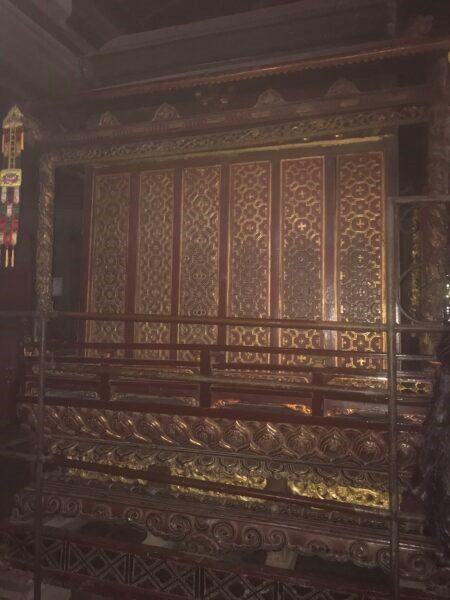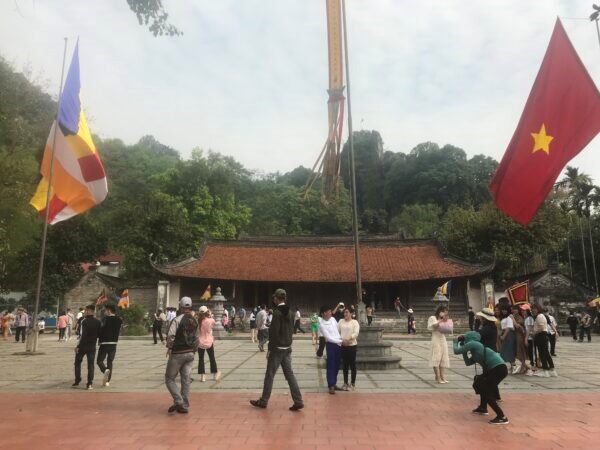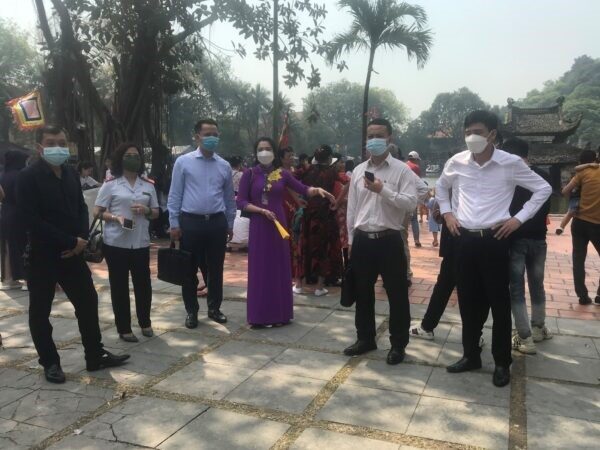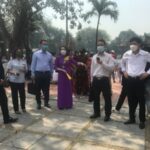Tu Dao Hanh was a legendary monk in history. Legend has it that after passing away, he was reincarnated as a King of the Ly dynasty and worshiped in many places.

Thay Pagoda
Quoc Oai is a beautiful land, the second hometown where Saint Tu Dao Hanh was born, grew up, practiced, and attained enlightenment and the place to keep his Jade Buddha. Saint Tu Dao Hanh spent his whole life practicing in Thay Pagoda.

The place to keep the Jade Buddha Tu Dao Hanh
Thay pagoda, also known as Thien Phuc Tu, lies on the side of Phat Tich mountain or Thay mountain in Sai Son commune, Quoc Oai district. At first, this was just a small temple called Huong Hai temple, dating from before the Ly dynasty. When Ly Nhan Tong (1072 – 1127) ascended the throne, the King rebuilt it to two clusters of pagodas: Cao Pagoda on the mountain (Son Tu mountain peek), also known as Hien Thuy Temple – where Tu Dao Hanh came to came to practice for the first time. Below, there is the Duoi pagoda (i.e Ca pagoda, Thay pagoda, Phat Tich pagoda, or Thien Phuc Tu). Thay Pagoda is located in a beautiful location in the area with a building consisting of 3 compartments, with a high steeple, and the temple walls have many autographs of famous scholars. The pagoda is a typical historical, cultural and spiritual relic of Hanoi and the North, belonging to Thuy Khue village, Sai Son commune, Quoc Oai district, about 20km from the center of Hanoi. The pagoda has been recognized by the State as a special national relic.
It is obvious that Thay Pagoda is a complex of relics built quite beautifully, with a harmonious natural landscape, a reservoir of water, high mountains, and fields below. Thay Pagoda is not only a destination of religious activities but also a famous scenic spot with caves, lakes, pagodas, flea markets, mountains and rivers which have typical characteristics of wonders, as in a couplets in the pagoda: “Huu dong, huu ho, huu thien nhi – Giang son nhat doi bieu ky quan”. As stated in the geographical section of the book “Categorized Records of the Institutions of Successive Dynasties” by Phan Huy Chu, “Phat Tich pagoda in Thuy Khue commune, Yen Son district, has another name Sai Son also called Co Sai with breathtaking mountain landscape: there is a lake at the foot of the mountain and a deep cave on the mountain. Thay Pagoda is the place where Tu Dao Hanh dumped his body. There are also traces of his head and heels on the cliff. In the mountain, there are Bo Da Institute and Huong Hai Temple, now Thien Phuc Pagoda, all made by Tu Dao Hanh (1[1])”.
Thay Pagoda was built more than 1000 years ago. The pagoda is 2,400m2 wide, consisting of three buildings running parallel to each other in the “三”shape, built on a high foundation of green stone bundles, with two rows of corridors running along both sides of the gable. Especially the magnificent and massive Bao Dien building, with only 36 holes punched with woods stacked in a solid manner. Visiting Thay Pagoda is to admire the artistic and architectural style of the ancient Vietnamese people with curved vamp-shaped roofs, carvings on tie-beams, elaborate and lively ridge-beams, sophisticated carved stone pedestals and statues of Ly Than Tong, Tu Dao Hanh, Tam The, etc.
Therefore, the Thay Pagoda Festival has been considered a spring travel festival and a festival of love couples since ancient times.
Thay Mountain has bamboos and pines
Thanh Hoa cave and a pagoda behind
(Folk)
And: Thay Pagoda Festival has Cac Co cave
Unmarried boys should not miss the chance to come here.
There are many historical books and records about Zen Master Tu Dao Hanh. In folklore, people always consider Tu Dao Hanh to be a monk, the Buddha, the King and the ancestor of the traditional puppetry profession. Because he is a patriarch, the people around always called him “Teacher”, so most places in Sai Son commune and Thay pagoda have the word Thay (“Teacher”) in their names.


People attending the ceremony and spring travel at Thay Pagoda festival 2022
He was originally from Ke Lang, which is now Lang Thuong ward, Dong Da district. His parents are Mr. and Mrs. Tu Vinh. He is a person who liked to have fun and socialize, so he often created many new games and songs, most notably the water puppetry. He also composed the opening rhymes for the games. For instance:
“Trinh lang trinh cha
Thuong ha tay dong
Tu canh hoa trung
Truong khong phong dong…”
The Thay Pagoda Festival takes place in 3 days, from the 5th to the 7th day of the third lunar month. This is one of the biggest festivals of the old Doai region: “Dam Swimming, Gia procession, Thay festival”, and: “Come to Lang Festival and Thay Festival on the 7th day of the third lunar month”.
Before entering the festival, people perform many rituals. The first ritual is the statue bathing ceremony, which is conducted before the 7th day of the 3rd lunar month. After the bathing, people also clean the sacrifices on the altars. Bathing water for Buddha Tu Dao Hanh is sprinkled everywhere like the Buddha’s rain to bring prosperity to people. The Buddha bath towel is separated as amulets for children to avoid evil spirits. March 7th is the main festival day. Next is the ceremony to worship Buddha and run around the makeshift platform. This is the biggest, most important and most impressive ceremony in Thay Pagoda festival. This ceremony is a religious performance with a combination of musical instruments. Then the monks with luxurious robes, holding flower sticks in their hands dance and perform to represent a non-stop journey of human life to reach for the beautiful.
The Thay Pagoda Festival is held every year, in which big-scale festivals are held once every 5 years. In 2010, it was very grandly held on the occasion of the 1000th anniversary of Thang Long – Hanoi and the 60th anniversary of the first planting of the Party’s flag on Sai Son Mountain. In big-scale festival, in addition to the solemn and respectful rituals, there are also jubilant performances, such as lion dance, dragon dance, tug of war, swinging, water puppetry. Today, there are also quan ho singing and cultural and sports exchange activities… The annual festival is held on a smaller scale.
Coming to Thay Pagoda, enjoying the festive atmosphere or visiting the scenery on leisurely occasions, visitors can go to the mountain, read poems carved on the rock by Trang Bung Phung Khac Khoan, and Trang Nguyen Nguyen Truc, admire the mountain and other sceneries; climb mountains, and visit caves. Above all that earthly joy, visitors feel like they are freed from their bodies, immersing themselves in a spiritual world of the Buddha realm, of the religious belief whose the Saint Tu Dao Hanh is the representative: Living a peaceful pure life, saving humanity, creating games for the people to enjoy, dying, becoming a Saint and reincarnating as King of the Ly Dynasty to keep helping the people and the country. There is no such another monk.

Inspecting Thay Pagoda Festival
In the past, during the festival of Thay Pagoda, a lot of monks and nuns, Buddhists from all over come here. The festival is huge. In the past few years, due to the influence of the COVID-19 pandemic, the Thay Pagoda did not organize the main festival, only organizing a simple, compact and economical ceremony; not many people attended the ceremony. In particular, the Management Board of Thay Pagoda relic and the abbot always pay great attention to environmental sanitation, fire prevention, ensuring security and order, and strictly implement 5K measures. The same went for the festival in 2022. As recorded at the main part of the festival by the inspection team of the Hanoi Department of Culture and Sports on April 7, 2022: The management board of the relic and the festival organizing board all prepare free sanitizers, medical masks, and regular staff at the entrance to Thay Pagoda relic. There are boards instructing people to strictly follow 5K rules, posters of the Code of Conduct in public places and instructions for medical declaration. The work of security and order at the relic is well ensured. People come to the ceremony quite orderly, do not throw garbage indiscriminately, showing the civilized lifestyle of the Trang An people.
Thanh Quy

